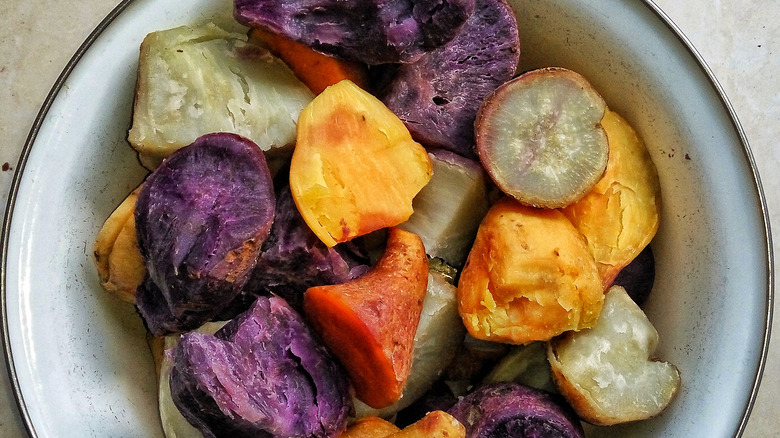Is There A Real Difference Between White And Orange Sweet Potatoes?
Sweet potatoes seem to come out of hibernation every fall and find their way onto every dinner table in America, tired of being fancy fries and ready to be topped with marshmallows and cut into perfectly wedged slices of pie. The most striking of sweet potato imagery features a bright autumnal orange, but sweet potatoes come in a very wide range of colors, each with their own slightly unique constitutions.
The spectrum of sweet potato flesh colors is indeed quite wide, but the most prevalent and recognizable are the orange and white potatoes. According to Bon Appétit, the lighter white sweet potatoes are milder and lack the sweetness of the characteristic orange sweet potatoes, which are also sometimes colloquially referred to as yams. It's important to note that yams are actually technically their own kind of tuber, but they are both often confused for each other and interchangeably referred to as "yams." Sweet potatoes can also range in colors from red to pink to purple.
Why the colors and how best to use them
The chemical makeup of the different kinds of sweet potatoes is what gives them their unique coloration. In orange sweet potatoes, the flesh is rich in beta-carotene, and in purple sweet potatoes, the flesh is rich in anthocyanins. The lighter colored the flesh, the less of each phyto-chemicals the plant produced, per the Harvard School of Public Health.
All kinds of sweet potatoes can generally be used interchangeably in most recipes; it's just important to remember that white sweet potatoes are lighter in both color and flavor. Not quite as visually striking with a far more subtle sweetness to them, per Southern Living. When cooking with them, the white sweet potatoes will also be a bit more crumbly and will act more like baking potatoes than their orange counterparts. Certain chefs have also found lots of artistic utility in the many different shades of the sweet potato, picking certain colors for certain uses.

